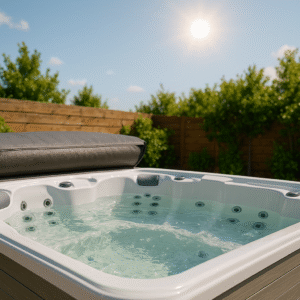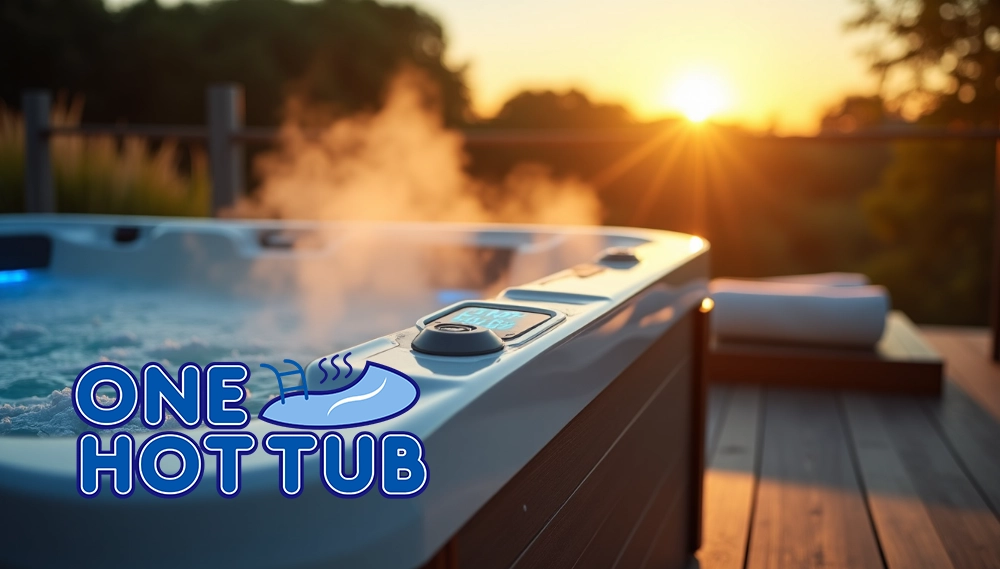Table of Contents - Hot Tub Water Maintenance – Everything up Need to Know
- Expert Hot Tub Water Maintenance Tips
- Understanding Hot Tub Water Basics
- Essential Hot Tub Water Maintenance Tips
- How to Keep a Hot Tub Clean and Clear
- Hot Tub Shocking: What, Why, and How
- Troubleshooting Hot Tub Water Problems
- Recommended Products for Hot Tub Water Care
- Final Thoughts – Hot Tub Water Maintenance Made Easy
This blog post may contain affiliate links. As an Amazon Associate I earn from qualifying purchases.
Hot Tub Water Maintenance – Everything up Need to Know
Expert Hot Tub Water Maintenance Tips
Understanding Hot Tub Water Basics
Why Chlorine and Bromine Matter
| Feature | Chlorine | Bromine |
|---|---|---|
| Ideal Level | 1-3 ppm | 3-5 ppm |
| Effectiveness | Fast-acting | Slower but longer-lasting |
| Skin Sensitivity | Can be harsh | Generally gentler |
| Cost | More affordable | Slightly more expensive |
| Smell | Stronger when reacting | Milder scent |
The Role of pH and Alkalinity
Common Water Problems: Green, Yellow, Cloudy Water
- pH or alkalinity throwing a tantrum
- Sanitizer levels on vacation
- Filters crying out for cleaning
- Body oils and lotions having a pool party
- Water that’s simply too old and full of dissolved solids
What is Biofilm and Why It’s Dangerous
Essential Hot Tub Water Maintenance Tips

Daily, Weekly, and Monthly Maintenance Tasks
test your hot tub waterDaily Tasks (Quick 5-minute routine):
- Peek at your water temperature and clarity (murky water = party’s over!)
- Get those jets bubbling for circulation (15-20 minutes twice daily keeps the nasties away)
- Skim off any floating debris after your soak (leaves don’t make good bath buddies)
- Add sanitizer after everyone’s done playing water baby
Weekly Tasks (Your 15-minute spa check-up):
- Test and balance pH (7.2-7.8 is your happy zone) and alkalinity (aim for 80-120 ppm)
- Check your sanitizer levels (chlorine should be 1-3 ppm; bromine 3-5 ppm)
- Give your hot tub the shock treatment (more on this magic trick later!)
- Rinse that hardworking filter cartridge
- Let your hot tub cover breathe for 1-2 hours (it needs fresh air too!)
Monthly Tasks (The deeper clean session):
- Treat your filter to a spa day with a specialized cleaner
- Play hot tub detective – inspect jets, pump, and heating elements
- Take a water sample to the pros for testing (they’ve got the fancy equipment)
- Clean and condition your hot tub cover (it’s like sunscreen for your spa!)
- Check for cabinet leaks (because nobody likes a crying hot tub)
Step-by-Step: How to Test and Balance Water
- Using Test Strips (The Easy-Peasy Method):
- Grab water from the middle of your tub (not the edges!)
- Quick dip of the strip (no swimming lessons for test strips!)
- Hold still for 15 seconds (patience is a virtue)
- Play color matching with the guide on the package
- Jot down your readings (your future self will thank you)
- Using Liquid Test Kits (For the Science Enthusiasts):
- Collect your water sample
- Add phenol red drops for pH testing (it’s like magic color-changing potion)
- Add OTO drops to check chlorine (more color-changing fun!)
- Hold against something white for best results
- Compare colors to the provided scales
- Balancing Your Water (Getting the Chemistry Just Right):
- Start with alkalinity (80-120 ppm) – it’s the foundation of happy water
- Then tackle pH (7.2-7.8 is the sweet spot)
- Next, adjust your sanitizer levels
- Don’t forget calcium hardness (175-250 ppm keeps your equipment smiling)
Do’s and Don’ts of Hot Tub Water Care
| DO | DON’T |
|---|---|
| Shower before soaking (your hot tub isn’t a bathtub!) | Use household cleaners (your hot tub isn’t a kitchen sink!) |
| Clean filters weekly (they’re working hard for you) | Block suction fittings (they need to breathe too) |
| Toss in tennis balls to absorb oils (they’re not just for playing fetch) | Assume clear water is clean water (looks can be deceiving) |
| Change water every 3-4 months (fresh start feels good)[39] | Add bubble bath (save it for your indoor tub) |
| Keep long hair tied back (nobody wants hair soup) | Jump in when you’re grimy (your hot tub isn’t a shower) |
| Pre-dissolve chemicals (they need to mingle first) | Mix chemicals directly (they might not play nice together) |
| Wear gloves when handling chemicals (protect those hands!) | Use mystery chemicals without labels (what’s in that bottle?!) |
| Circulate water daily (30 minutes minimum) | Crank heat above 40°C (you’re not making soup) |
How to Keep a Hot Tub Clean and Clear
Simple Cleaning Routines for Beginners
Daily Must-Dos:
- Always cover your hot tub when it’s not being used (keeps leaves and critters out!)
- Skim off any floating bits with a net after each soak
- Wipe that pesky “ring around the tub” with white vinegar and a soft cloth
Weekly Wonder-Workers:
- Give the hot tub shell a gentle scrub with a spa-specific cleaner (no harsh stuff!)
- Toss in a few tennis balls to magically absorb oils from the water surface
- Wipe down your cover with a 10% bleach-water mix to kick mildew to the curb
How to Clean Hot Tub Filters Properly
Your Three-Step Filter Cleaning Plan:
- Weekly Rinse (The Quick Fix):
- Power down your hot tub
- Pop out that filter (gently does it!)
- Spread those pleats apart with your fingers
- Give it a good garden hose rinse (easy on the pressure!)
- Let it dry completely before putting it back
- Monthly Spray (The Middle Ground):
- Remove your filter for some special treatment
- Spray it with a specialized filter cleaning solution
- Let it sit and work its magic for 10-15 minutes
- Rinse until the water runs clear
- Dry thoroughly before reinstalling
- Quarterly Soak (The Deep Dive):
- Mix up filter cleaner in a bucket following the directions
- Dunk that filter completely underwater
- Let it soak for 12-24 hours (overnight works great!)
- Rinse super thoroughly to remove all cleaning solution
- Dry completely before returning to duty
How Often to Drain and Refill Your Hot Tub
How can you tell it’s definitely time for fresh water?
- Your water stays cloudy even after adjusting chemicals
- Bubbles and foam party won’t stop despite anti-foam treatments
- Strange smells are crashing your relaxation time
- Water looks darker than usual
- You’re dumping in more and more chemicals just to maintain balance
| DO | DON’T |
|---|---|
| Use spa-specific cleaning products | Use household cleaners or dish soap |
| Clean filters with proper cleaners | Use pressure washers on filters |
| Drain water every 3-4 months | Wait until water problems appear |
| Clean the shell while drained | Refill immediately without cleaning |
| Use a hose filter when refilling | Use untreated water directly |
Hot Tub Shocking: What, Why, and How
When to Shock Your Hot Tub
- After a wild hot tub party (or any heavy use with multiple soakers)
- Weekly as part of your regular maintenance (even if you’ve barely used it!)
- When your water looks cloudy despite your chemical levels being spot-on
- Before jumping into a hot tub that’s been sitting unused (hello, vacation home!)
- When your test strips show sanitizer levels lower than total chlorine (chemistry magic!)
- After freshly filling your tub with new water
- Any time your nose detects funky smells coming from your spa
Step-by-Step Guide to Shocking
- Take that cover completely off (never shock with it on – your cover will thank you!)
- Test and adjust your pH to between 7.2-7.6 (this sweet spot makes your shock work its best magic)
- Turn on your jets to low speed with air valves closed (perfect circulation without splashing chemicals everywhere)
- Measure your shock treatment carefully according to package directions
- Usually about 35-40g of chlorine shock per 1500 liters of water
- Or roughly 17g of non-chlorine shock per 1500 liters if you prefer that route
- Sprinkle the shock evenly across your water’s surface (like seasoning a delicious soup!)
- Keep that cover off for at least 20 minutes to let chemicals off-gas
- Test your water before you hop back in (safety first!)
Pros and Cons of Chlorine vs Non-Chlorine Shock
Type
- Chlorine Shock
- Non-Chlorine Shock
Pros
- • Powerful sanitizing punch (bacteria beware!)• Excellent for killing algae and bacteria• Works wonders with heavy bather loads• Easier on your wallet
- • Jump back in after just 20-30 minutes (perfect for impatient soakers!)• No strong chemical odor• Gentler on hot tub covers and equipment• Doesn’t add calcium or cyanuric acid to your water
Troubleshooting Hot Tub Water Problems
How to Fix Green, Yellow, or Cloudy Water
Green Water
- Test your water chemistry (all parameters, please!)
- First things first – balance your pH (aim for 7.2-7.6) and alkalinity (80-120 ppm)
- Blast that algae with chlorine shock (think of it as your water’s superhero)
- Let your filter run non-stop for 24 hours (it’s working overtime, but for a good cause)
- Give your filter a thorough cleaning afterward (it deserves some TLC after catching all that gunk)
Yellow Water
- Balance your water chemistry (the foundation of all water fixes)
- Turn off your heater (heat just makes yellow problems worse)
- Add a hefty dose of chlorine shock (more than you’d normally use)
- Run those jets with the cover off for several hours
- If your sanitizer levels drop like a rock within 24 hours, shock again!
Cloudy Water
- Check those filters (they might be hiding more gunk than you’d believe!)
- Test and tweak your pH and alkalinity
- Apply non-chlorine shock for a quick clarity boost
- Crank up your filtration time (more filtering = clearer water)
How to Handle Foamy Water
- Test your water chemistry right away
- Pay special attention to pH (foam loves an imbalanced pH)
- Add an oxidizer to break down those pesky oils
- Use a defoamer for quick relief (think of it as your foam’s kryptonite)
Do’s
- Shower before tubbing (your water will thank you!)
- Rinse swimwear super thoroughly
- Clean filters weekly (they’re your first defense)
- Toss in tennis balls to soak up oils (they’re oddly effective!)
Don’ts
- Slather on lotions before soaking
- Go overboard with defoamer (a little goes a long way)
- Ignore that suspicious ring around the water
- Think foam is just part of the hot tub experience
Signs You Need to Replace Your Water
- Foam that keeps coming back despite your best efforts
- Water looking funky even after you’ve balanced all chemicals
- Strange smells lingering despite proper sanitizer levels
- Chemical readings that bounce all over the place
- Three-month anniversary of your last water change
- TDS (Total Dissolved Solids) reading that’s 1500 ppm higher than when you started
Recommended Products for Hot Tub Water Care
Best Water Test Kits (with Features Table)
| Test Kit Type | Features | Best For |
|---|---|---|
| Test Strips | • Quick results (15 seconds!) • Tests multiple parameters • Affordable • 2-year shelf life | Beginners, routine testing |
| Digital Readers | • No more squinting at color charts • Higher accuracy • Stores reading history • Some connect to smartphones | Regular users seeking precision |
| Liquid Test Kits | • Gold standard for accuracy • Titration method for precise readings • Tests more parameters • More detailed results | Experienced owners, persistent water issues |
Top Hot Tub Shocks (with Features Table)
| Shock Type | Features | Best For |
|---|---|---|
| Chlorine Shock | • Powerful germ-killing punch • Knocks out algae and bacteria • Budget-friendly option • 12-24 hour waiting period before use | Heavy contamination, algae problems |
| Non-Chlorine Shock (MPS) | • Ready to soak in just 20-30 minutes! • No chemical smell to ruin your mood • Gentle on your hot tub cover and equipment • Powers by Active Oxygen | Regular maintenance, sensitive skin |
Best Hot Tub Filters (with Features Table)
| Filter Type | Features | Maintenance Requirements |
|---|---|---|
| Cartridge Filters | • Most popular for home spas • Traps tiny particles (10 microns!) • Super easy to replace • 3-5 year lifespan | Weekly rinse, monthly cleaning, new one every 1-2 years |
| Sand Filters | • Almost maintenance-free • Captures larger debris • Built like a tank • 5-7 year lifespan | Occasional backwashing, new sand every 3-5 years |
| DE (Diatomaceous Earth) | • Crystal-clear water (traps 5 micron particles) • Best water clarity possible • Super efficient filtration • Replace grids every 2-3 years | Regular backwashing, add DE powder every 1-3 months |
Final Thoughts – Hot Tub Water Maintenance Made Easy
FAQs
Q1. How often should I test and balance my hot tub water?Q2. What’s the ideal pH range for hot tub water?Q3. How frequently should I shock my hot tub?Q4. When should I drain and refill my hot tub?Q5. Why is regular filter cleaning important?



